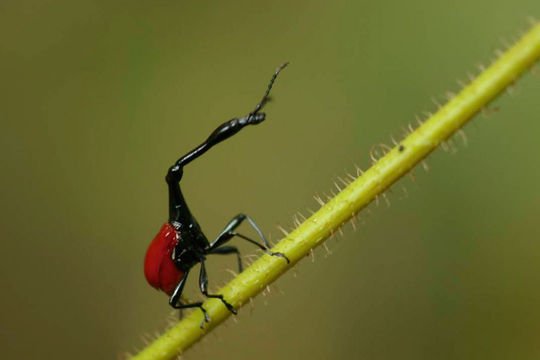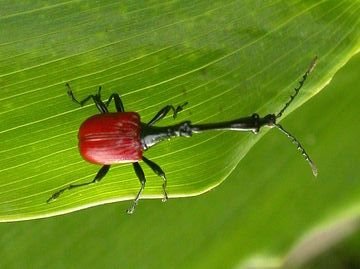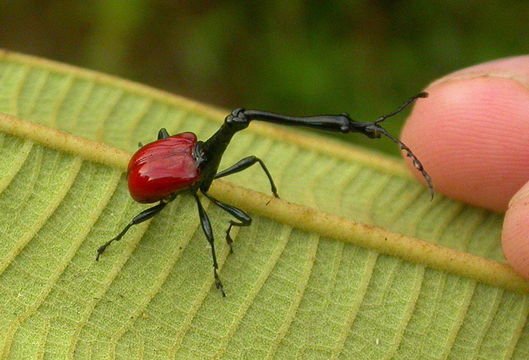Hello steemians! After a short break, I am back to bring a new strange animal to your attention! (here's the last one if you missed it!).
Today, I am gonna show you a newly discovered insect that is best known for it's abnormally elongated necked.. Not surprisingly, the name of this creature is...
Giraffe Weevil

With its bizarrely long neck, the weird-looking giraffe weevil looks more like a tiny alien rather than a real insect. Scientifically described as Trachelophorus giraffa, this 1-inch long species is endemic to the forests of Madagascar and was only discovered back in 2008.
Let's learn more about this peculiar creature!
Tell me more about the neck! Why is it so freaking long?

First, let me tell you that this a sexually dimorphic species, meaning there are different characteristics beyond the differences in the sexual organs.. In this case, the main difference lies in the length of the neck, with males having a neck that is 2 to 3 times longer compared to females.
But what is its' purpose? Giraffes use their necks to reach leaves in tall trees. But for this insect it seems to play a different role. The long necks are used during courtship! Males fight and push each other to win the heart of females.
These conflicts are usually non-lethal, the loser just retreats and lives to try another day. After the fight, the female mates with the winner and uses her legs to fold and roll a nearby leaf into a nest. She then curls up the end of the leaf and lays one egg inside. Interestingly, each female rolls and curls its nest, in a unique fashion.
In the meantime, the fathers stay close-by, probably guarding the nest from any incoming tiny insects that might parasitize on the eggs. Once the leaf-nest is complete, the female snaps it from the plant and it falls to forest floor. This whole process takes approximately half an hour.
The leaf will now provide protection and food to the newborn insect once it hatches. This behavior was actually first noted in 2011 when it was filmed for the BBC natural history series Madagascar.
And speaking of video.. there you go:
How does it spend its' day?
They are peaceful & herbivorous insects that spend most of their life around small trees of the species Dichaetanthera arborea, commonly known as (surprise, surprise!) as the "giraffe beetle tree". They also depend on these trees for food.
Despite being capable of flight, they very rarely venture away from the trees. They mind their own business and don't show any aggression towards other species. In case you wonder, they don't sting or bite.

Is it threatened?
This is a newly discovered species and no serious effort has been made to assess its conservation status. However, their populations appear to be stable and healthy. Fortunately, these beautiful creatures don't appear to have any natural predators and most importantly, they are not threatened by human related activities.
Extra Animal: The unrelated and also Giraffe-like Lasiorynchus barbicornis

Commonly known as the New Zealand giraffe weevil, this is a highly distinctive, straight-snouted weevil endemic to New Zealand. As you can see in the photo, it also has a long neck and is actually the longest beetle found in New Zealand. Males measure up to 9 cm, and females up to 5 cm. In males the elongated snout or rostrum can be nearly as long as the body.
This is it for today, see you in tomorrows strange animal post :)
Photo Credit
All photos released under creative commons license. Click here for more of them!
References
SteemSTEM & Steemiteducation
Please consider supporting the @steemstem project. SteemSTEM is a community driven project which seeks to promote well written & informative Science Technology Engineering and Mathematics postings on Steemit. Click here to join the chat and learn more! The steemstem project is run by @justtryme90, @lemouth and some other cool guys & gals :)You may also want to check, @steemiteducation, a project for steemian educators and people posting educative content
More Strange Animals To Come
I will be posting one new strange animal each and every day so if you enjoyed this post make sure to follow me and let's discover together some of the world's most strange and bizarre creatures! An upvote and resteem would be nice too :P In the meantime, you may want to check out these 5 Solar-Powered animals, learn how many legs the world's leggiest creature has and discover the world's largest one-cell organism!

